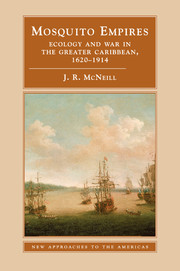Book contents
- Frontmatter
- Contents
- List of Maps
- List of Abbreviations Used in the Footnotes
- Preface
- Acknowledgments
- 1 The Argument (and Its Limits) in Brief
- PART I SETTING THE SCENE
- PART II IMPERIAL MOSQUITOES
- PART III REVOLUTIONARY MOSQUITOES
- 6 Lord Cornwallis vs. Anopheles quadrimaculatus, 1780–1781
- 7 Revolutionary Fevers, 1790–1898: Haiti, New Granada, and Cuba
- 8 Conclusion: Vector and Virus Vanquished, 1880–1914
- Bibliography
- Index
7 - Revolutionary Fevers, 1790–1898: Haiti, New Granada, and Cuba
Published online by Cambridge University Press: 05 June 2012
- Frontmatter
- Contents
- List of Maps
- List of Abbreviations Used in the Footnotes
- Preface
- Acknowledgments
- 1 The Argument (and Its Limits) in Brief
- PART I SETTING THE SCENE
- PART II IMPERIAL MOSQUITOES
- PART III REVOLUTIONARY MOSQUITOES
- 6 Lord Cornwallis vs. Anopheles quadrimaculatus, 1780–1781
- 7 Revolutionary Fevers, 1790–1898: Haiti, New Granada, and Cuba
- 8 Conclusion: Vector and Virus Vanquished, 1880–1914
- Bibliography
- Index
Summary
If Nature is against us, we will fight it and make it obey us.
– Simon BolívarThe defeat of Cornwallis in 1781 decided one American Revolution, but more soon followed. In the latter half of the eighteenth century, free populations in the Americas grew in number, wealth, confidence, and ambition. Their frustration with old regime monarchies that limited their opportunities for trade and for political voice gradually mounted. That frustration contributed to revolutions in French and Spanish colonies, as it had in thirteen of Britain's in North America. In St. Domingue uniquely, the revolution evolved into a massive slave uprising. Monarchs responded to each revolution with armed force in hopes of maintaining their American empires. But when they sent their legions to the mosquito coasts of the Caribbean, they ignited epidemics that destroyed their armies far more thoroughly than any revolutionary brigades could. Canny revolutionaries recognized the power of differential immunity to yellow fever, and conducted their wars accordingly.
This chapter tells the stories of yellow fever (and malaria) and revolution in St. Domingue, the Viceroyalty of New Granada, and Cuba. The stories span a century, from the 1790s to the 1890s. But in each case, the broad pattern was the same.
- Type
- Chapter
- Information
- Mosquito EmpiresEcology and War in the Greater Caribbean, 1620–1914, pp. 235 - 303Publisher: Cambridge University PressPrint publication year: 2010



